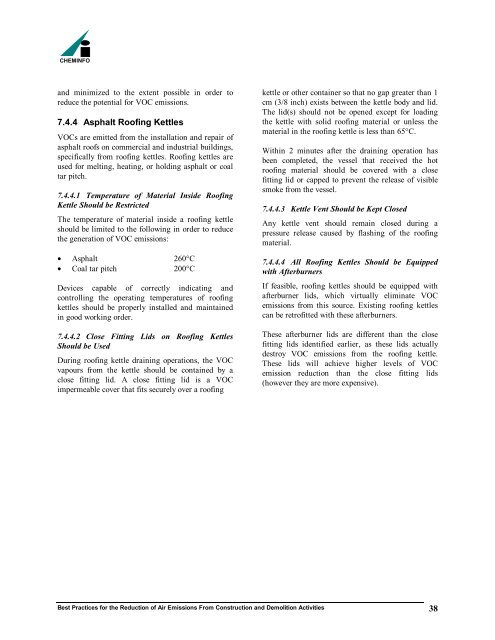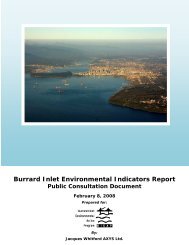Best Practices for the Reduction of Air Emissions From Construction ...
Best Practices for the Reduction of Air Emissions From Construction ...
Best Practices for the Reduction of Air Emissions From Construction ...
You also want an ePaper? Increase the reach of your titles
YUMPU automatically turns print PDFs into web optimized ePapers that Google loves.
CHEMINFO<br />
and minimized to <strong>the</strong> extent possible in order to<br />
reduce <strong>the</strong> potential <strong>for</strong> VOC emissions.<br />
7.4.4 Asphalt Ro<strong>of</strong>ing Kettles<br />
VOCs are emitted from <strong>the</strong> installation and repair <strong>of</strong><br />
asphalt ro<strong>of</strong>s on commercial and industrial buildings,<br />
specifically from ro<strong>of</strong>ing kettles. Ro<strong>of</strong>ing kettles are<br />
used <strong>for</strong> melting, heating, or holding asphalt or coal<br />
tar pitch.<br />
7.4.4.1 Temperature <strong>of</strong> Material Inside Ro<strong>of</strong>ing<br />
Kettle Should be Restricted<br />
The temperature <strong>of</strong> material inside a ro<strong>of</strong>ing kettle<br />
should be limited to <strong>the</strong> following in order to reduce<br />
<strong>the</strong> generation <strong>of</strong> VOC emissions:<br />
• Asphalt 260°C<br />
• Coal tar pitch 200°C<br />
Devices capable <strong>of</strong> correctly indicating and<br />
controlling <strong>the</strong> operating temperatures <strong>of</strong> ro<strong>of</strong>ing<br />
kettles should be properly installed and maintained<br />
in good working order.<br />
7.4.4.2 Close Fitting Lids on Ro<strong>of</strong>ing Kettles<br />
Should be Used<br />
During ro<strong>of</strong>ing kettle draining operations, <strong>the</strong> VOC<br />
vapours from <strong>the</strong> kettle should be contained by a<br />
close fitting lid. A close fitting lid is a VOC<br />
impermeable cover that fits securely over a ro<strong>of</strong>ing<br />
kettle or o<strong>the</strong>r container so that no gap greater than 1<br />
cm (3/8 inch) exists between <strong>the</strong> kettle body and lid.<br />
The lid(s) should not be opened except <strong>for</strong> loading<br />
<strong>the</strong> kettle with solid ro<strong>of</strong>ing material or unless <strong>the</strong><br />
material in <strong>the</strong> ro<strong>of</strong>ing kettle is less than 65°C.<br />
Within 2 minutes after <strong>the</strong> draining operation has<br />
been completed, <strong>the</strong> vessel that received <strong>the</strong> hot<br />
ro<strong>of</strong>ing material should be covered with a close<br />
fitting lid or capped to prevent <strong>the</strong> release <strong>of</strong> visible<br />
smoke from <strong>the</strong> vessel.<br />
7.4.4.3 Kettle Vent Should be Kept Closed<br />
Any kettle vent should remain closed during a<br />
pressure release caused by flashing <strong>of</strong> <strong>the</strong> ro<strong>of</strong>ing<br />
material.<br />
7.4.4.4 All Ro<strong>of</strong>ing Kettles Should be Equipped<br />
with Afterburners<br />
If feasible, ro<strong>of</strong>ing kettles should be equipped with<br />
afterburner lids, which virtually eliminate VOC<br />
emissions from this source. Existing ro<strong>of</strong>ing kettles<br />
can be retr<strong>of</strong>itted with <strong>the</strong>se afterburners.<br />
These afterburner lids are different than <strong>the</strong> close<br />
fitting lids identified earlier, as <strong>the</strong>se lids actually<br />
destroy VOC emissions from <strong>the</strong> ro<strong>of</strong>ing kettle.<br />
These lids will achieve higher levels <strong>of</strong> VOC<br />
emission reduction than <strong>the</strong> close fitting lids<br />
(however <strong>the</strong>y are more expensive).<br />
<strong>Best</strong> <strong>Practices</strong> <strong>for</strong> <strong>the</strong> <strong>Reduction</strong> <strong>of</strong> <strong>Air</strong> <strong>Emissions</strong> <strong>From</strong> <strong>Construction</strong> and Demolition Activities 38
















